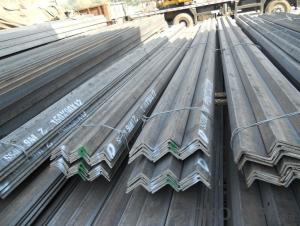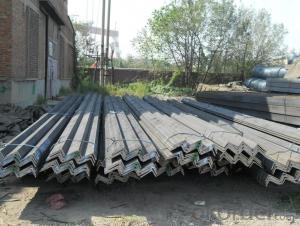High Quality Unequal Steel Angle
OKorder Service Pledge
OKorder Financial Service
You Might Also Like
Specifications of Unequal Steel Angle:
1.Standards: GB
2.Length: 6m,9m,12m
3.Material: Q235, Q345 or Equivalent
4. Size:
Size (mm) | Mass (mm) | Size (mm) | Mass (mm) |
| 150*75*9 | 15.4 | 150*90*9 | 16.5 |
| 150*75*10 | 17.0 | 150*90*10 | 18.2 |
| 150*75*12 | 20.2 |
Packaging & Delivery of Unequal Steel Angle:
1. Transportation: the goods are delivered by truck from mill to loading port, the maximum quantity can be loaded is around 40MTs by each truck. If the order quantity cannot reach the full truck loaded, the transportation cost per ton will be little higher than full load.
2. With bundles and load in 20 feet/40 feet container, or by bulk cargo, also we could do as customer's request.
3. Marks:
Color mark: There will be color marking on both end of the bundle for the cargo delivered by bulk vessel. That makes it easily to distinguish at the destination port.
Tag mark: There will be tag mark tied up on the bundles. The information usually including supplier logo and name, product name, made in China, shipping marks and other information request by the customer.
If loading by container the marking is not needed, but we will prepare it as customer request.
*If you would like to get our price, please inform us the size, standard/material and quantity. Thank you very much for your attention.
- Q:How do you prevent steel angles from vibrating?
- There are a few ways to prevent steel angles from vibrating. One effective method is to use vibration damping materials such as rubber pads or isolation mounts between the steel angles and any adjacent surfaces. Another approach is to add additional supports or braces to the steel angles to enhance their stability and reduce any potential vibrations. Additionally, ensuring proper tightening of fasteners and connections can help minimize vibrations.
- Q:How do you calculate the section modulus of a steel angle?
- The section modulus of a steel angle can be calculated by dividing the moment of inertia of the angle cross-section by the distance of the furthest point from the centroid to the extreme fiber.
- Q:Are steel angles suitable for architectural cladding?
- Yes, steel angles can be suitable for architectural cladding. Steel angles offer structural support and can be used to create clean lines and sharp corners in architectural designs. They are durable, weather-resistant, and can be customized to match the desired aesthetic. Additionally, steel angles provide versatility in terms of installation and can be easily attached to different building materials.
- Q:Are steel angles easy to install?
- Installing steel angles can be a relatively straightforward task, depending on the specific use and the expertise level. These angles are commonly employed in construction projects for structural support, reinforcement, and framing purposes. The installation procedure generally entails measuring, cutting, and securing the steel angles in the desired location using appropriate fasteners like screws, bolts, or welding. Nevertheless, it's worth noting that the ease of installation may vary depending on the project's complexity and the skills possessed by the individual or team carrying out the installation. Those with professional experience or expertise may find it easier to install steel angles due to their familiarity with the materials and techniques involved. Conversely, those lacking experience may require guidance or assistance from professionals to ensure proper installation and adherence to safety guidelines. In summary, with the correct tools, knowledge, and precautions, steel angles can be relatively easy to install. It is always advisable to follow the manufacturer's instructions, seek professional advice when necessary, and prioritize safety to achieve optimal results during the installation process.
- Q:Can steel angles be used for HVAC systems?
- Yes, steel angles can be used for HVAC systems. Steel angles are commonly used in construction and engineering applications due to their strength and versatility. In HVAC systems, steel angles can be used in various ways such as providing support for ductwork, mounting and securing equipment, and creating framework for ventilation systems. Steel angles are durable, resistant to corrosion, and can withstand the weight and pressure of HVAC components. Additionally, they can be easily welded or bolted together to create custom structures and configurations. Overall, steel angles are a suitable choice for HVAC systems due to their strength, durability, and flexibility in design.
- Q:What are the standard sizes for steel angles?
- The standard sizes for steel angles vary depending on the country and industry standards. In general, steel angles are available in a range of sizes to accommodate different applications and structural requirements. Common sizes include equal angles, which have equal sides, and unequal angles, which have different lengths on each side. Some commonly used standard sizes for steel angles include 25x25mm, 30x30mm, 40x40mm, 50x50mm, 65x65mm, 75x75mm, 100x100mm, 150x150mm, and 200x200mm. However, it is important to note that these sizes may vary and can be customized based on specific project requirements and regional standards.
- Q:What are the disadvantages of using steel angles?
- Some disadvantages of using steel angles include their susceptibility to corrosion and rust, limited design options due to their fixed angle shape, and their heaviness which can make them difficult to handle and install. Additionally, steel angles may require additional reinforcement and support to prevent bending or twisting under heavy loads.
- Q:Can steel angles be used for shelving and storage racks?
- Yes, steel angles can be used for shelving and storage racks. Steel angles are commonly used in construction and industrial applications due to their strength and durability. They provide excellent support and stability, making them suitable for organizing and storing various items on shelves and racks.
- Q:How do you calculate the slenderness ratio of a steel angle?
- To calculate the slenderness ratio of a steel angle, you need to determine the length and the moment of inertia of the angle section. The slenderness ratio is a measure of how slender or slender a member is, and it helps in determining its stability and ability to resist buckling. First, measure the length of the steel angle, which is the distance between its two ends. This length should be measured in the same unit as the dimensions of the angle section. Next, calculate the moment of inertia of the steel angle section. The moment of inertia is a measure of the section's resistance to bending and is typically denoted by the symbol "I". It depends on the dimensions of the angle section and can be obtained from reference tables or calculated using mathematical formulas. Once you have the length and moment of inertia of the steel angle, you can calculate the slenderness ratio using the formula: Slenderness ratio = (Length of angle) / (√(Moment of inertia)) Make sure the length and moment of inertia are expressed in the same unit before performing the calculation. The resulting slenderness ratio will be a dimensionless value. It is important to note that the slenderness ratio is used to determine the appropriate design criteria and allowable loads for the steel angle. Different design codes or standards may have specific limits or guidelines for the maximum slenderness ratio that can be used safely in different applications. Therefore, it is crucial to consult the relevant design codes or seek professional engineering advice to ensure the correct and safe use of the steel angle.
- Q:Are there any environmental concerns associated with steel angles?
- Yes, there are several environmental concerns associated with steel angles. One of the main concerns is the production process of steel angles, which involves the extraction of iron ore, coal mining for coke production, and the emission of greenhouse gases during the steelmaking process. These activities contribute to deforestation, air pollution, and climate change. Additionally, the disposal of steel angles at the end of their life cycle can be problematic. Steel is not biodegradable and can take hundreds of years to decompose in landfills. Improper disposal of steel angles can lead to soil and water contamination, posing a risk to ecosystems and human health. Furthermore, the transportation of steel angles from production facilities to construction sites can contribute to carbon emissions and air pollution. The energy required for transportation increases the overall environmental impact of steel angles. To mitigate these environmental concerns, there are several strategies that can be adopted. Firstly, using recycled steel instead of virgin steel can significantly reduce the environmental footprint of steel angles. Additionally, implementing energy-efficient technologies in the steel production process can help minimize greenhouse gas emissions. Finally, responsible disposal and recycling of steel angles at the end of their life cycle can help reduce the environmental impact.
1. Manufacturer Overview |
|
|---|---|
| Location | |
| Year Established | |
| Annual Output Value | |
| Main Markets | |
| Company Certifications | |
2. Manufacturer Certificates |
|
|---|---|
| a) Certification Name | |
| Range | |
| Reference | |
| Validity Period | |
3. Manufacturer Capability |
|
|---|---|
| a)Trade Capacity | |
| Nearest Port | |
| Export Percentage | |
| No.of Employees in Trade Department | |
| Language Spoken: | |
| b)Factory Information | |
| Factory Size: | |
| No. of Production Lines | |
| Contract Manufacturing | |
| Product Price Range | |
Send your message to us
High Quality Unequal Steel Angle
OKorder Service Pledge
OKorder Financial Service
Similar products
New products
Hot products
Related keywords



























